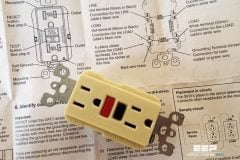Good electrician never forgets
It’s not easy to be a good electrician, that’s for sure. Things you studied hard (or still studying) are gradually being forgotten, especially electrical formulas. Well, these 20 questions tend to wake up your memory and test your electrical knowledge :)

The answers require you to determine volts, current or amperes. Beyond the questions, in practice when you are working as an electrician, your occupation will frequently require you to know the basics of Ohm’s law, fraction conversion, and other mathematical methods.
Ok, let’s have a 20-question quiz and test your knowledge in electrical calculations! By the way, to check your results, take a peek for answers at the bottom of the article.
Question #1
The load that can be used for the service calculation for a dwelling unit with a range rated at 13 KW is which of the following:
- 13 kw
- 8.4 kw
- 8 kw
- 5.5 kw
Question #2
A motor that draws 4.5 kilowatts from the power line and delivers 5 horsepower has an efficiency equal to which of the following:
- 90.5 percent
- 83 percent
- 75 percent
- 45 percent
Question #3
Based on the figure below, the voltage across the 5 amp load after the neutral is opened, if both loads have resistance and the power factor is 1.0, would be which of the following:


- 240 volts
- 180 volts
- 150 volts
- 100 volts
Question #4
If the raceway is 12 feet long, the allowable size for a rigid steel conduit with four 4/0 XHHW conductors and one #3 bare equipment grounding conductor would be which of the following:
- 1 inch
- 1 1/2 inches
- 2 inches
- 2 1/2inches
Question #5
If an air conditioner motor compressor unit consumes 8500 volt amperes of power at a line voltage of 240 volts, then the minimum total circuit ampacity shall be which of the following:
- 35.4 amps
- 44.3 amps
- 70.2 amps
- 85 amps
Question #6
A four-story office building has a required load of 60000 volt amperes and single-phase 240 volt feeder circuits supplying the general lighting load, which means that the minimum required current in the feed circuit ungrounded conductors is which of the following:
- 240 amps
- 250 amps
- 270 amps
- 480 amps
Question #7
A 1500 square foot single-family, one-bath dwelling has a 12 kW electric range and a 5.5 kW, 240 volt dryer. The general lighting load is which of the following:
- 1500 VA
- 2500 Va
- 4000 VA
- 4500 VA
Question #8
This same 1500 square foot single-family, one-bath dwelling with a 12 kW electric range and a 5.5 kW, 240 volt dryer has a general lighting load in amperes of which of following:
- 20 amps
- 33.5 amps
- 37.5 amps
- 40 amps
Question #9
The minimum number of branch circuits required for 12 kW range in this same 1500 square foot single-family, one-bath dwelling would be which of the following:
- Two 2-wire 20 amp circuits
- Three 15 amp 2-wire circuits
- One 2-wire 20 amp circuit
- Two 2-wire 15 amp circuits
Question #10
Provided that the calculation for the neutral for the feeder and service is 14550VA, then the calculated load for neutral for this same 1500 square foot single-family, one-bath dwelling would be which of the following:
- 37.5 amps
- 40.4 amps
- 60.6 amps
- 77.5 amps
Question #11
A church building has the outside dimensions of 100 feet x 200 feet, which means that the minimum lighting load required for the general lighting only would be which of the following:
- 2000 volt amperes
- 10000 volt amperes
- 12000 volt amperes
- 20000 volt amperes
Question #12
If there are three resistors in a series circuit, labeled R1, R2, and R3, with a total power used of 225 watts, and the individual power used by R2 is 75 watts and by R3 is 100 watts, then the power used by resistor R1 is which of the following:
- 100 watts
- 75 watts
- 50 watts
- 25 watts
Question #13
In a 100 volt circuit with a resistance of 25 ohms, the current flowing through the circuit is which of the following:
- 1.25 amps
- 2.5 amps
- 4 amps
- 5 amps
Question #14
Three parallel circuits with a voltage of 150 volts each produce a total current of which of the following:
- 50 volts
- 150 volts
- 225 volts
- 450 volts
Question #15
If a parallel circuit has thee circuits, C1, C2, and C3, with a total current of 600 volts, then the individual current in each circuit is equal to which of the following:
- 600 divided by the resistance of each circuit
- 200 volts
- 180 volts
- It is impossible to calculate without knowing the value of each circuit
Question #16
A 60-cycle AC circuit of 120 volts and 12 amperes has a true power value of which of the following:
- 1220 volt-amperes
- 1220 watts
- 720 volt-ampers
- 720 watts
Question #17
If a 480 volt motor has a full-load current of 34 amperes, then the standard disconnecting means must be which of the following:
- 66 amps
- 50 amps
- 39.1 amps
- 40 amps
Question #18
A 32 watt metal halide fixture that uses 0.578 percent of its total wattage has a reciprocal wattage of which of the following:
- 31.42
- 1.73
- 0.422
- 5%
Question #19
An electric motor that runs at 3/4 of its full-load potential of 200 amperes is operating at which of the following:
- 150 amps
- 75 amps
- 25 amps
- 15 amps
Question #20
Three 9-feet long sections of 1 ½ inch rigid metal conduit can be installed in which of the following:
- A trench that is 42 inches deep and concrete encased
- A trench that is 8.2296 meters long
- A trench that is 3 feet x 3 feet
- A trench that is 2.7432 meters long
Answers //
Let’s see how good electrician you are!
To prove you are good electrician, your results should be the same as below provided answers. NEC articles mentioned in answers you can observe in a free draft version of NEC 2014 //
- B – 8 kw + 5 percent of 8 kw = 8.4 kw
- B – 5 × 746 watts ÷ 4500 watts = 83%
- B – R = 15 a load so 120 ÷ 15 = 8ohms; R = 5 a load so 120 ÷ 5 = 24; I for neutral open would then be 240 ÷ (8 + 24) = 7.5 amps; E across 5 a load =7.5 amps × 24 = 180 volts
- C – Reference Section [344.22] and Chapter 9, tables 1, 4, 5 and 8. The area of four 4/0 is 4 × 0.3197 = 1.2788; the area of one #3 is 0.058; 1.278 + 0.053 = 1.3318 square inches. A 2-inch rigid conduit allows for 40 percent of the area of 1.363 square inches.
- B – Reference Table [440.32]. I = E ÷ R, so take 8500 ÷ 240 = 35.4; from Table [440.32] take 125 percent of 35.4 = 44.3 amps
- B – Reference Chapter 9, Annex D. I = E ÷ R, so take 60000 ÷ 240 = 250 amps
- D – Reference Section [220.40] 1500 ft³ at 3 VA per foot³ = 4500 VA
- C = 4500 VA ÷ 120 volts = 37.5 amps
- A – Reference Section [210.1(C)(1)]
- C – 145500 VA ÷ 240 volts = 60.6 amps
- D – 100 inches × 200 inches = 20,000 square feet. Table [220.12] lists 1 VA per foot required for churches, so 1 × 20000 = 20000 VA
- C – Take the total power of 225 – R2 value of 75 = 150; 150 – R3 value of 75 = 50 watts
- C – Ohm’s law I = E ÷ R, so 100 ÷ 25 = 4 amps
- D – Total current is the sum of all of the circuits. 150 + 150 + 150 = 450
- B – In a parallel circuit the voltage is the same across each resistance load. Therefore, you can divide the total load of 600 by 3 circuits and know that each circuit has a value of 200 (600 ÷ 3 = 200).
- D – 120 volts × 12 amps = 1440 volt-amperes (which is the apparent power) 1440 × 0.5 = 720 watts
- D – Reference Section [430.110(A)], which states that the disconnecting means for motors rated 600 volts or less must be at least 115 percent of the full-load current rating of the motor. Therefore, you would take 115 percent (or 1.15) × 34 amps = 39.1 amps. However, the question specifically asks for the standard disconnect size, and since 39.1 is not an industry standard, the answer is 40 amps.
- B – This question has nothing to do with the total wattage of 32 watts. The only thing the question is asking for is the reciprocal value of 0.578, which is calculated by dividing 1 by 0.578.
- A – 3/4 is 75 percent or 0.75, so 200 amps × 0.75 = 150 amps.
- B – It does not matter that the conduit is 11½ inches. The answer is the conversion of yards to meters. 1 yard = 0.9144 meters. A 9-feet section of conduit is 3 yards long, so 3 × 0.9144 = 2.7432 meters. However, there are three sections of the conduit, so you have to multiply 2.7432 × 3 = 8.2296 meters.
Reference // Electrician’s Exam Study Guide (Purchase at Amazon)











Question 1 makes no sense so I assume there is a translation into English & regulation issue there.
It states that there is a “Range” (cook-top?) load rated at 13 kW.
Then the solution implies that the figure used for connection calculations should only be 8.5 kW
(I assume they mean 8.5kVA)
Since when is the residence connected with cabling only capable of 8.5kVA to supply a load of 13kW?
I think some of the answers are not accurate or need to be explained such as in No. 15 and 16
let’s explain the no. 16 the apparent power is a true power multiplied by the power factor and the power , you used is 0.5 which is not given in the question and it ‘s very poor. I mean it could be 1220 watts instead of 720 watts if we consider the power factor 85% which is more practical. any way I hope you are not bothered because of my comment, and thank you.
Q 15 answer should be A
We have three circuits which may not be equal hence 600 divided by resistance of each circuit
I agree with some of the earlier comments. The use of volts and amps in some of the questions is incorrect which does reduce credibility. Refer to Q14 and Q15 specifically. Q18 is simply a trick question and has nothing to do with being a good electrician. The term reciprocal wattage is not a standard or defined term.
You need to have someone verify the labels in the questions before posting. Credibility is lost with such mistakes.
What are you talking about? I don’t understand your comment.
I think that the answer of Q# 8 to be checked, because the assumed voltage is 240 V